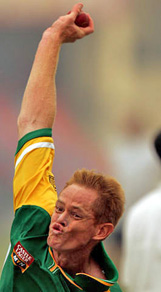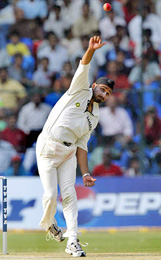COACHING
Good-Length, Out and In
- By Polly Umrigar A 'good-length' delivery challenges and questions the judgment of even a class batsman. A batsman plays fuller deliveries off the front foot and short deliveries off the back foot. A good-length delivery lands on a spot not as close as the one on which a fuller delivery lands, nor as farther down the wicket as the one on which a short ball lands.The good-length spot varies from batsman to batsman, depending upon his height and reach. The good-length spot for a shorter batsman will be closer to the stumps than that for a taller batsman.
Generally, the good-length area can be indicated as between six feet and twelve feet away from the batsman for a fast bowler, and between four and six feet away from the batsman for a slow bowler.
The other types of deliveries are:
(i) Full toss
(ii) Yorker
(iii) Half volley
(iv) Long-hop
Full-tosses, half-volleys and long-hops are regarded as ordinary deliveries that quality batsmen are expected to punish. A full-toss comes on to the bat directly without bouncing even once, a long-hop pitches and then 'sits up', demanding to be hit, and a half-volley lands in the 'groove', a perfect ball for a batsman to play a crashing front-foot stroke. However, these deliveries do fetch wickets every now and then. Cricket is an unpredictable sport after all!
The Yorker can be one of the effective weapons in a fast bowler's armoury.
SWING AND SWERVE

A high-arm action -
Shaun Pollock in the nets
'Swing' is the term that is applied to
the movement of a ball in the air, caused by the shine on the ball and angle of
the seam - not through spin. 'Swerve' is movement of the ball in the air with a
lot of spin on the ball.
An off-spinner turning from off to the leg-side will find his delivery 'drifting' towards the slips. A leg-spinner who spins the ball from the leg-side towards the slips will find the ball drifting towards or outside the batsman's feet. Top-spin causes a ball to drop quicker than normal.
The stronger the wind blowing towards the ball, the greater is the swerve. That is the main reason slow bowlers should almost invariably bowl against the wind.
Certain conditions are desirable to obtain maximum swing.
A shiny new ball will swing in humid / heavy conditions.
Wind will also aid swing.
As these factors disappear, so will swing.
An off-spinner turning from off to the leg-side will find his delivery 'drifting' towards the slips. A leg-spinner who spins the ball from the leg-side towards the slips will find the ball drifting towards or outside the batsman's feet. Top-spin causes a ball to drop quicker than normal.
The stronger the wind blowing towards the ball, the greater is the swerve. That is the main reason slow bowlers should almost invariably bowl against the wind.
Certain conditions are desirable to obtain maximum swing.
A shiny new ball will swing in humid / heavy conditions.
Wind will also aid swing.
As these factors disappear, so will swing.
OUTSWINGER
The ball is held between the first two fingers (which are apart) and the thumb, with the seam upright, the index finger on the left side of the seam and the second finger just placed on the other side with the thumb under the ball and on the seam. The seam should point towards the slips and the shiny side of the ball should face the leg-side.In delivering the outswinger, a right-handed bowler may occasionally obtain more swing by allowing his arm to stray slightly to the right. The more the ball swings, the more important it will be to pitch it in the right area. One should try to make the batsman come onto the front foot.
A late outswinger is one wherein the ball flies dead straight three quarters of the length of the pitch, and then suddenly dips one way or the other. This can be achieved with a high-arm action. It can happen when the wicket is grassy.
INSWINGER

After the 'release' -
Steve Harmison.
The ball can be held in almost the
same way as for the outswinger, except that the shiny should face the opposite
direction (off-side) with the seam pointing towards fine leg. The fingers
should be closer to each other.
While delivering the inswinger, a bowler needs to keep his action as high as possible, almost flicking his right ear at the point of release. The palm of the hand should turn towards the leg-side as the ball is delivered.
With regard to wind direction, it is generally agreed that a mild breeze coming towards the bowler from the direction of third slip will help the inswinger, whilst a breeze coming from the area between square leg and the wicketkeeper will assist the outswinger. Too much breeze is not good as it can retard the bowler's pace, although most fast bowlers won't mind having the wind behind them to help them bowl quicker.
One shouldn't overdo swing. To keep the batsmen on tenterhooks, it is advisable to mix 'swingers' with straight deliveries.
While delivering the inswinger, a bowler needs to keep his action as high as possible, almost flicking his right ear at the point of release. The palm of the hand should turn towards the leg-side as the ball is delivered.
With regard to wind direction, it is generally agreed that a mild breeze coming towards the bowler from the direction of third slip will help the inswinger, whilst a breeze coming from the area between square leg and the wicketkeeper will assist the outswinger. Too much breeze is not good as it can retard the bowler's pace, although most fast bowlers won't mind having the wind behind them to help them bowl quicker.
One shouldn't overdo swing. To keep the batsmen on tenterhooks, it is advisable to mix 'swingers' with straight deliveries.